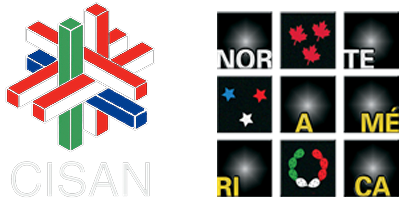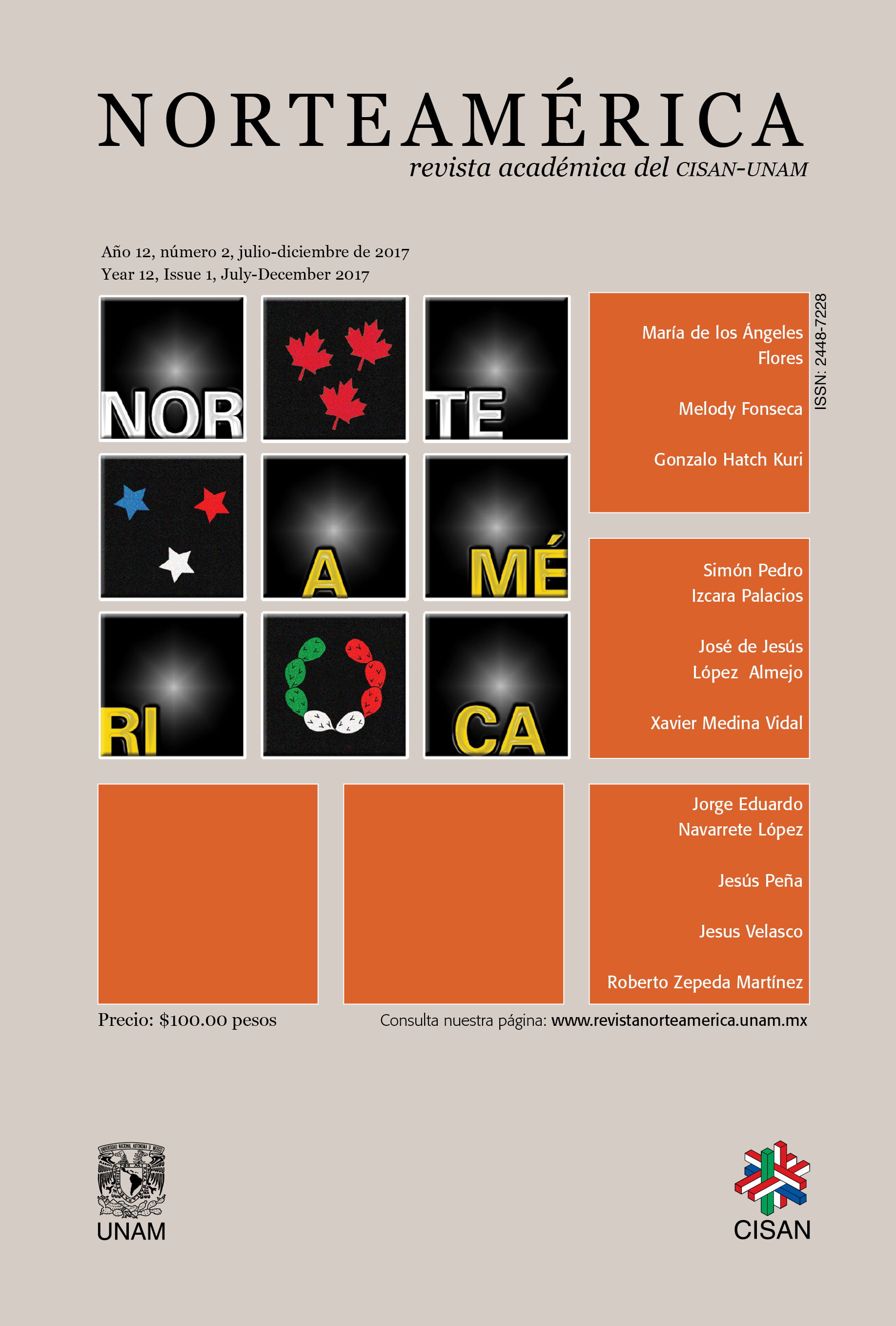Abstract
This article’s main objective is to document the change in the Mexican government’s dominant, accepted view of lobbying in the U.S., which went from refusing to use it, following the principle of non-intervention, to its institutionalization and constant use as pressure strategies. Mexican lobbying in Washington was an old but discreet Mexican foreign policy practice until 1990; that was when it began to be used and openly institutionalized when it became necessary to influence certain decisions of our northern neighbor that affected Mexico. In conclusion, Salinas’s administration began this change in Mexican foreign policy; Vicente Fox publicly acknowledged the need for it; and Felipe Calderon continued and even consolidated it.
References
Álvarez, P. S. (2012). Los Tratados de Bucareli y la rebelión delahuertista. México DF: Instituto Nacional de Estudios Históricos de las Revoluciones de México.
Andrews, G. (1991). Shoulder to Shoulder? The American Federation of Labor, The United States, and the Mexican Revolution, 1910 – 1924. Berkeley.
Atieh, J. (11 de 2010). Foreign Agents: Updating FARA To Protect American Democracy. Journal of International Law, 31(2).
Bertrab, H. V. (1997). Negotiating NAFTA: A Mexican Envoy's Account. The Washington Papers, 2(1).
Birnbaum, J. (2005). Lobbyists-Why the Bad Rap? En A. C. Loomis, American Politics, Classic and Contemporary Readings. New York: Houghton Mifflin Company.
Clive, T. (1998). Interest Group Regulation Across the United States: Rationale, Development and Consequences. Parliamentary Affairs Review.
Dominguez, J. (1997). Mexico’s New Foreign Policy: States, Societies, and Institutions. En R. O. Velasco, Bridging the Border, Transforming Mexico-US Relations. Rowman and Littlefield Publishers, Inc.
Eisenstad, T. (1992). Nuevo estilo diplomático: cabildeo y relaciones públicas (1986-1991). Foro Internacional, XXXII(5).
Enmiendas Constitucionales de Estados Unidos. (1992). Recuperado el 16 de 11 de 2015, de Primera Enmienda Constitucional: http://www.gpo.gov/fdsys/pkg/GPO-CONAN-1992/pdf/GPO-CONAN-1992-10-2.pdf
Escamilla-Hamm, P. (2001). , “How Mexico Built Support for the Negotiation of the North American Free Trade Agreement: Targeting thMexican Diaspora in the United States. Irvine, Cal.: Doctoral Dissertation in Political Sciences.
Flores, A. C. (1978). Conferencia Dictada en la Casa Naval de Morelos. Memoria de El Colegio Nacional. Morelia: El Colegio Nacional.
Gómez-Robledo, M. (2005). , El caso Avena y otros nacionales mexicanos (México C. Estados Unidos de América) ante la Corte Internacional de Justicia. Anuario Mexicano de Derecho Internacional, V.
Gónzalez, G. G. (2007). Democratización y política exterior: ¿el fin del predominio presidencial? México DF: CIDE.
Green, R. (1999). Intervención de la Embajadora Rosario Green en 54 periodo de sesiones de la Asamblea General de Naciones Unidas. En N. Unidas (Ed.), 54 periodo de sesiones de la Asamblea General de Naciones Unidas. New York.
Hall, L. (2000). Alvaro Obregón: Power and Revolution in Mexico, 1911-1920. Texas A&M University Press.
Hijuelos, C. F. (enero-marzo de 1988). El cabildeo en Washington. Foro Internacional, XXVIII(3).
Knight, A. (1997). Dealing with the American Political System: An Historical Overview 1910-1995. En R. d. Velasco, Bridging the Border. New York: Roman & Littlefield.
Krauze, E. (2002). Siglo de Caudillos: Biografía Política de México 1810 – 1910 (1ra ed.). México DF: Fábula.
Legro, J. (2009). ¿De dónde viene el internacionalismo estadounidense? En A. S. Cruz, El constructivismo y las relaciones internacionales. Mexico DF: CIDE.
Lowery, D. (January de 2007). Why Do Organized Interests Lobby? A Multi-Goal, Multi-Context Theory of Lobbying. Leiden, Polity, 39(1).
Meyer, H. A. (1989). A la sombra de la Revolución Mexicana. México DF: Cal y Arena.
Montfort, R. P. (2006). Down Mexico Way. Estereotipos y Turismo Norteamericano en el México de 1922. México: CIESAS.
Ojeda, M. (2007). Vicente Fox: el rompimiento de Facto con Cuba. Foro Internacional, XLVII(190).
Ojeda, M. (2010). Alcances y límites de la política Exterior de México. México DF: El Colegio de México.
Presidencia de la República de México. (2012). Plan Nacional de Desarrollo 2007-2012. Recuperado el 23 de 12 de 2013, de http://pnd.calderon.presidencia.gob.mx/index.php?page=documentos-pdf
Rabasa, E. (2005). Los siete principios básicos de la Política. México DF: Instituto de Investigaciones Jurídicas.
Santamaría, A. (1998). Los Lobbies como instrumentos de política exterior México y Cuba frente a EEUU. En C. Maya, México en América (Vol. 1). Universidad Autónoma de Sinaloa: Plaza y Valdés editores.
Silva-Herzog, J. (2005). Democracy and the International Press. En A. Selee, Perceptions and Misconceptions in U.S. - Mexico Relations. Washington : The Woodrow Wilson Center and Letras Libres.
Tolchin, M. (01 de 05 de 1986). Deaver Case. (T. N. Times, Ed.) Recuperado el 26 de 12 de 2013, de Martin Tolchin, “Conservatives Say Deaver Case Hurts Reagan”, Thhttp://www.nytimes.com/1986/05/01/us/conservatives-say-deaver-case-hurts-reagan.html
Turner, J. K. (1908). México Bárbaro (55a ed.). México DF: Costa Amic.
U. S. Government. (2010). Foreign Relations and Intercourse: Tittle 22. Washington: Authenticated U. S. Government Information.
U. S. House of Representatives. (2010). Lobbying Disclosure Act Guidance. Recuperado el 24 de 07 de 2013, de en el sitio web oficial de la Secretaría de la Cámara de Representantes del Gobierno de Ehttp://lobbyingdisclosure.house.gov/amended_lda_guide.html
U.S. Department of Justice. (12 de 2011). FARA Report. Recuperado el 15 de 11 de 2014, de http://www.fara.gov/reports/FARA_SAR_12312011.pdf
U.S. Department of Justice. (2014). FARA. Recuperado el 07 de 01 de 2014, de FARA: http://www.fara.gov/annualrpts.html
Velasco, J. (1999). Reading Mexico, Understanding the United States: American Transnational Intellectuals in the 1920s and 1990. The Journal of American History.
Wilson, C. (2010). Mexico in the Transnationalization of U.S. Politics: Exploring the Limited Success of the Mexico Lobby. (A. U. Washington, Ed.)
Authors who publish with this journal agree to the following terms:
Authors retain copyright and grant the journal right of first publication with the work simultaneously licensed under a Creative Commons Attribution License that allows others to share the work with an acknowledgement of the work's authorship and initial publication in this journal.
Authors are able to enter into separate, additional contractual arrangements for the non-exclusive distribution of the journal's published version of the work (e.g., post it to an institutional repository or publish it in a book), with an acknowledgement of its initial publication in this journal.
Authors are permitted and encouraged to post their work online (e.g., in institutional repositories or on their website) prior to and during the submission process, as it can lead to productive exchanges, as well as earlier and greater citation of published work.



